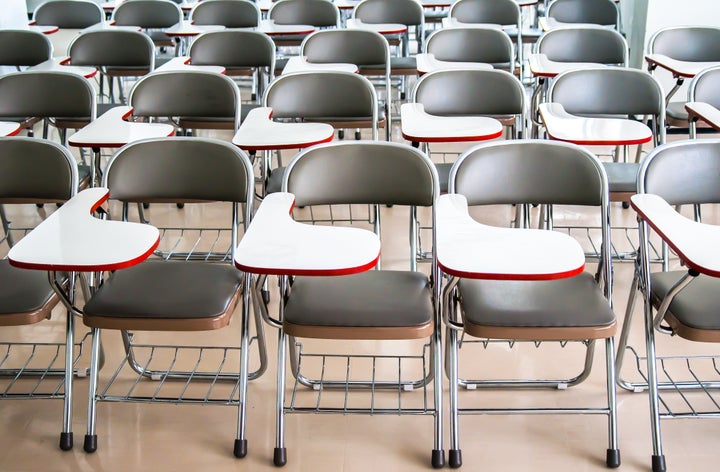
It’s the kind of thing that happens in a flash, 10 seconds of braggadocio that could just as instantly be lost in a sea of testosterone and bad decisions.
The boy is white, about 15, sporting a neat haircut and a Clemson sweatshirt. He glares into the camera at an invisible adversary, slamming his left fist into his open right hand for effect. “I’ll f**king knock your ass back to the f**king cotton fields, you f**king p***y.” A high school basketball buzzer sounds. His wingman, a shorter kid sitting to his right, tauntingly sticks his tongue in and out. “One swing’s all you need to go down, you f**king n****r.”
It could have ended there, but this is 2018, and naturally it was captured on Snapchat, which forgets everything except the things you’ll regret. The 10-second video has now been viewed more than 100,000 times, the first kid has been doxxed and his suburban Virginia Catholic school has opened an investigation that’s been covered by local media.
It is not clear what kind of consequences the kid or his wingman faced at school. That’s something that private schools don’t typically disclose, despite the very public nature of this menacing behavior. (I left messages asking for comment with the relevant diocese.) Some might hope for both boys to be expelled.
But expulsion is not always the way to go, for many reasons. Ironically, one of the biggest reasons is the glaring racial disparities in expulsion rates.
Most Americans think of discipline as a way to improve one’s moral character and behavior. In France, there is no exact translation for the word “discipline” as it applies to children, according to Bringing Up Bébé author Pamela Druckerman. Instead, the French use words like “educate.” For both peoples, the instructional part of discipline is key. You correct people to make them better, not to disqualify them from society.
If you banish a child anytime they make a mistake, they are robbed of the opportunity to learn, and society ultimately suffers for it. And the point of school, after all, is to learn. School, like church, is actually the best place to make mistakes. As I tell my kids all the time, if you already knew everything, I would let you stay home.
The problem is that too many black children are being robbed of the opportunity to learn. Black kids are being systematically thrown out of schools for doing far less than the white kids in the racist video. Allison R. Brown, who now leads the Communities for Just Schools Fund, spent years enforcing civil rights laws in the educational system as a trial attorney with the U.S. Department of Justice. She heard chilling stories about black children being kicked out of school for infractions as trivial as farting, smiling and wearing the wrong uniform.
Brown was a pioneer in convincing the federal government to address what some activists call the “school-to-prison pipeline.” This begins with the epidemic of black and Latinx children being forced out of schools for minor or questionable offenses. It is part of the same stream documented by Michelle Alexander in The New Jim Crow, which counts the costs of criminal justice and disciplinary policies that have banished whole swaths of black communities from society, with no route to redemption. This process begins as early as preschool.
A recent study that followed all Texas seventh-graders for six years found that nearly 60 percent were suspended or expelled within that period. In 97 percent of the cases, these disciplinary acts were entirely within the discretion of school administrations, which means that Texas secondary schools essentially decided that most of the children in their care were not teachable at some point. This also means that the majority of Texas parents had to interrupt work and figure out childcare. And African-American students were disproportionately disciplined.
Racial disparities in school discipline were addressed in a 2014 guidance package from the U.S. departments of Justice and Education, which was designed to provide tools for fostering healthy school climates while complying with longstanding civil rights laws. The Obama administration also beefed up racial discipline data collection for all school districts. These were smart policies, and they worked. School suspensions plummeted, and parents and administrators were forced to think about the consequences of school discipline disparities.
Unfortunately, the Trump administration’s secretary of education, Betsy DeVos, is considering rescinding that guidance. Some teachers have called the rules onerous and claim that reform was “moving too fast.” This is wrong-headed. Schools, teachers and the justice system need tools to handle the inevitable discipline challenges, and they should demand them. But if discipline means keeping kids out of school, we are missing the whole point of school.
How we choose to discipline children is often a function of how much we empathize with them, whether we see ourselves in them. In this way, disciplinary decisions are shaped by the implicit biases we all have, and psychologists are learning more and more about how those are shaped by race. As we strive to rid such bias from our systems of justice and education, a good step is gathering data and letting the numbers talk. What punishment does a white kid receive for hate speech and inciting violence? What punishment does a black kid receive for wearing the wrong uniform? We have to count the problem and constantly adjust school policies so that they’re effective and fair.
Which brings me back to the racist video. I can only imagine the challenge ahead for these kids’ families and for teachers and administrators, both at their school and many others around the country. It may be that a stiff punishment such as expulsion might deter this kind of dehumanizing and possibly dangerous behavior, and stop it from spreading and terrorizing more classmates. But would that be more effective than, say, a field trip to Virginia cotton fields, or lessons on toxic masculinity and why vaginas, aka “pussies,” are far from weak? While these forms of restorative justice may be more costly in the short term, they may also help those boys to learn the error of their ways more effectively than simply casting them out.
We adults have a job on our hands raising and educating children in the current toxic environment. It’s not a job for Twitter mobs, cynics or part-timers. And it’s not a job for those unwilling to ask tough, sometimes counterintuitive questions, or those unwilling to take the longer or wider view. Our job is to treat kids ― all kids ― as kids, to rise to the challenges of teaching them, and to resist the powerful urge to cut and run.
Dr. Natalie Hopkinson is an assistant professor of communication, culture and media studies at Howard University and author of the forthcoming book A Mouth Is Always Muzzled.
